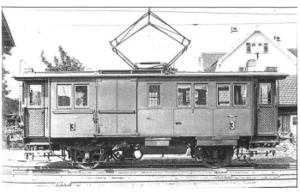LAG No. 360 and 361
| LAG No. 360 and 361 | |
|---|---|
|
Company photo LAG 360
|
|
| Numbering: | LAG No. 360 and 361 DR ET 184.4 DB ET 184.41 |
| Number: | 5 |
| Manufacturer: | mechanical: MAN electrical: SSW Oerlikon |
| Year of construction (s): | 1895 |
| Retirement: | 1959 |
| Axis formula : | Bo |
| Genre : | C PW 2L |
| Gauge : | 1435 mm ( standard gauge ) |
| Length over buffers: | 10,020 mm |
| Total wheelbase: | 4,500 mm |
| Service mass: | 360: 16,200 kg 361: 14,100 kg |
| Friction mass: | 360: 16,200 kg 361: 14,100 kg |
| Wheel set mass : | 360: 10,700 kg 361: 9,700 kg |
| Top speed: | 40 km / h |
| Continuous output : | 90 kW (122 hp) |
| Driving wheel diameter: | 1,000 mm |
| Power system : | 650 V = |
| Power transmission: | Overhead line |
| Number of traction motors: | 2 |
| Seats: | 30th |
| Classes : | 2nd / 3rd |
The railcars LAG No. 360-361 were two-axle electric railcars of the local railway company (LAG) for various branch lines of the company in standard gauge . The vehicles are considered to be the first electric vehicles to run on a full line . After the nationalization of the LAG , the railcars were taken over by the Deutsche Reichsbahn and designated as ET 184 41 and ET 184 42 . The vehicles were in service until around 1962.
history
The LAG operated several branch lines in southern Germany that were electrified and operated with railcars before 1900.
These vehicles were on the Baden-Württemberg railway Meckenbeuren Tettnang- the LAG used to about 1942nd A sidecar was procured together with the railcars. Then they were replaced by LAG No. 501 to 505 , whereupon the ET 184 42 was retired. The ET 184 41 was converted from the same source as a contact line investigation vehicle and could still be used in the form until 1959, where it should have been used on the Bad Aibling – Feilnbach local railway . After 1959 the car is said to have been used as a non-powered auxiliary tower car until 1962.
Decommissioning and scrapping data cannot be found in the literature, only photos have been preserved.
construction
An old data sheet identifies the two vehicles as CPw ET Wü 65 . Its construction comes from a passenger car of the Royal Bavarian State Railways . From this the car body was taken over. At the time of delivery, the 360 car was equipped in two classes with a 2nd class compartment for 11 people and a 3rd class compartment for 21 people. Car 361 , on the other hand, was only 3rd class from the start. A little off-center between the two passenger compartments, a baggage and mail compartment with a large sliding door was set up; both passenger compartments were placed between this compartment and the boarding areas.
The chassis of the vehicle was a riveted steel construction. The car body was made of wooden profiles and clad with sheet metal on the outside. Originally the boarding rooms were open and the engine driver only performed his duties behind a windbreak; At an unknown point in time, both entry rooms were closed with a trapezoidal porch with two doors. In addition, the 360 car was also single-class with two third-class compartments.
Both cars were manufactured mechanically by MAN . The electrical equipment, which consisted of the vehicle control system and the two four-pole traction motors designed in Tatzlager design , came from the Siemens-Schuckert works for the 360 car and from Oerlikon for the 361 . Originally the engine output was only 19 kW, later more powerful engines with 44 or 42 kW were installed. At the start of operation, the railcar had a pantograph with a roller on the roof , this construction detail was modernized later.
literature
- Horst J. Obermayer: Paperback German railcars. Franckh'sche Verlagshandlung, Stuttgart 1973. ISBN 3-440-04054-2 .
- Bäzold / Rampp / Tietze: Electric railcars German railways , Alba Verlag, Düsseldorf 1997, ISBN 3-87094-169-3
Web links
- Website from the locomotive magazine about the ET 184.4
- Website about a model of the vehicle
- LAG 360 as DB ET 184 41 1954 on the Joachim Schmidt Railway Foundation
Individual evidence
- ↑ a b c Internet page about the vehicles on the Lok-Magazin
- ↑ Horst J. Obermayer: Paperback German Triebwagen. Franckh'sche Verlagshandlung, Stuttgart 1973. ISBN 3-440-04054-2 , page 110
- ↑ Photo of the LAG 360 on the locomotive magazine
- ↑ Photo of a model of the vehicle
- ↑ MIBA website about the model of the vehicle
- ↑ a b c Bäzold / Rampp / Tietze: Electric railcars of German railways , Alba Verlag, Düsseldorf 1997, ISBN 3-87094-169-3 , page 253
- ↑ Photo of the railcar from the first few years on Lok Magazin
